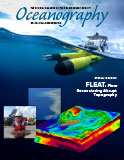Article Abstract
The North Equatorial Current (NEC) transports water westward around numerous islands and over submarine ridges in the western Pacific. As the currents flow over and around this topography, the central question is: how are momentum and energy in the incident flow transferred to finer scales? At the south point of Peleliu Island, Palau, a combination of strong NEC currents and tides flow over a steep, submarine ridge. Energy cascades suddenly from the NEC via the 1 km scale lee waves and wake eddies to turbulence. These submesoscale wake eddies are observed every tidal cycle, and also in model simulations. As the flow in each eddy recirculates and encounters the incident flow again, the associated front contains interleaving temperature (T) structures with 1–10 m horizontal extent. Turbulent dissipation (ε) exceeds 10−5 W kg−1 along this tilted and strongly sheared front. A train of such submesoscale eddies can be seen at least 50 km downstream. Internal lee waves with 1 km wavelengths are also observed over the submarine ridge. The mean form drag exerted by the waves (i.e., upward transport of eastward momentum) of about 1 Pa is sufficient to substantially reduce the westward NEC, if not for other forcing, and is greater than the turbulent bottom drag of about 0.1 Pa. The effect on the incident flow of the form drag from only one submarine ridge may be similar to the bottom drag along the entire coastline of Palau. The observed ε is also consistent with local dissipation of lee wave energy. The circulation, including lee waves and wake eddies, was simulated by a data-driven primitive equation ocean model. The model estimates of the form drags exerted by pressure drops across the submarine ridge and due to wake eddies were found to be about 10 times higher than the lee wave and turbulent bottom drags. The ridge form drag was correlated to both the tidal flow and winds while the submesoscale wake eddy drag was mainly tidal

